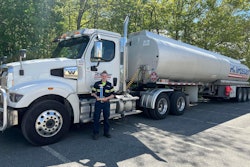
The following is a recap from last week's CCJ webinar "Finding and keeping drivers in a demand-driven job market," sponsored by Bestpass. If you missed the event live, you can download a recording by signing up here.
Challenger Motor Freight (CCJ Top 250, No. 77) is working to onboard a new member to its driver roster: a young woman of South Asian descent. But bringing a woman onto the team isn’t an everyday occurrence for the Canadian carrier.
Boysie Dindyal, director of recruiting and retention at Challenger, said the company still has some work to do around forming a better strategy for attracting women drivers – a population that carriers have shifted more recruiting focus to amid a massive driver shortage that has been exacerbated by pressures from an influx of supply chain issues following the onset of the Covid-19 pandemic.
As carriers compete for very few fish in a large pond, they’re discovering and implementing new ways to attract talent, reaching beyond the traditional demographics of a driver and offering more competitive pay, benefits and home-time options, among other things.
One of the top considerations in recruitment and retention during these trying economic times is driver pay.
“We need to be priority fair to the drivers on what they should be paid. There are a lot of things going on in the economy. Things cost a lot more. We are cognizant of that,” Dindyal said. “We did address it, and then secondly just to ensure that we're in the game from a recruiting perspective as well.”
According to the American Trucking Associations, driver wages were up considerably in 2021 compared to 2019 with a slow migration away from mileage-based pay. According to a CCJ survey conducted last year, 68% of fleet respondents said they raised driver wages at least once in 2021, and 31% said they raised driver wages more than once, while 7% raised it three times or more.
Tim Chrulski, chief operations officer at Ohio-based Garner Transportation, said his company has also increased pay in the last couple of years but has applied a different approach more recently that involves a pay-for-performance system, which compensates drivers based on four categories related to things like safety and fuel efficiency. And Wisconsin-based Roehl Transport (No. 59), which offers accident-free pay, was one of the first carriers to begin paying drivers based on practical miles.
But Tim Norlin, Roehl's vice president of driver employment, said one of the things that makes the company stand out from other carriers is its home-time and fleet options.
“We know one size doesn't fit all so we try to tailor our approach to drivers to offer them a job that they're looking for,” he said. “Maybe, if we don't have it, we'll create it, and that's one of the successes that we've had through the Covid pandemic is creating jobs that drivers are looking for.”
Women in trucking
Norlin said that is one of the reasons why the company has been named a top company for women to work for in transportation on multiple occasions – a recognition Garner also recently earned. Women make up about 50% of the workforce but less than 10% of truck drivers. But lately, there has been a big emphasis on recruiting women.
Garner provides opportunities for different lifestyles. Chrulski said Garner drivers are typically out for a week at a time, but the company now offers a five-day program where drivers can select what days of the week they want to work and a four-on-four-off program that he said is popular among women drivers, as well as some dedicated and local freight opportunities.
Drivers at Roehl are paid based on their experience and length of haul – not gender, which Norlin said broadcasting that has greatly benefitted the company and garnered it an above national average number of female drivers. The company also caters to women’s comfort by providing women trainers for those who are uncomfortable being in the cab with a man, and all trainers receive gender sensitivity training.
Another component is home time.
“Females are typically the caregivers of the family; that's just traditionally how it's been, and they don't want to be out two, three weeks at a time,” Norlin said. “With Rhoel’s unique freight situation and the number of home daily and home weekly regional jobs that keep them close, we've been a little bit more attractive for female drivers.”
But women aren’t the only demographic carriers are going after.
Youth movement
Roehl and the female-owned Garner both are participating in the Safe Driver Apprenticeship Pilot Program created to help shore up the driver population by allowing drivers between the ages of 18 and 20 with an intrastate CDL to operate interstate commerce under specific conditions.
This is a demographic trucking companies have historically lost out on as these young professionals often land in other careers because of age requirements that restrict them from driving commercial vehicles at the time they exit high school and begin looking at schools or jobs.
Both carriers already had apprenticeship programs in place – a requirement to participate in the DRIVE-Safe Act under 21 pilot – with Roehl’s originally designed for military veterans to use their G.I. Bill benefits.
Chrulski said participating in the program expands a carrier’s recruiting opportunities because “you get that seal of approval” from the government.
But just like with women, he said it’s important to have a different mindset when it comes to training younger drivers.
“We kind of took the bull by the horns several years back in 2015 when we started an apprenticeship program. We are in a rural community; there are plenty of farm kids around with a different set of expertise,” he said. “When we began that program, one of the big things I wanted to consider with that was the … individuals that were going to be doing the training had adequate understanding that those mentalities are going to be a little bit different.
“Some of the benefit there is you've got an individual behind the wheel of a younger age that's going (to adapt) quicker than the 50-year-old guy or gal, so I think there’s a lot of great opportunity there and … it's great that the government is getting on board with us now and putting a program together to help trucking companies be able to train that next generation.”
Norlin said it is long overdue for the industry to be able to offer interstate driving jobs to 18- to 20-year-olds because Roehl has long been training 18-year-old CDL holders to drive intrastate. But not all companies can offer that whether it be because of the length or type of loads they haul or because of insurance purposes.
Challenger has a 21-year-old age requirement, but it does have its own driver school that it recruits from as well as a seven-week, entry-level training program that those drivers and drivers from other top-tier driving schools have to attend.
Dindyal said the company averages about 160 entry-level drivers every year – almost 90% of which have remained with the company.
These recruiters said they have found that training new drivers in house is extremely helpful in retaining them.
“And those drivers tend to be safer,” Norlin said. “We all want to hire experienced drivers, but what we found is that experienced drivers come with bad habits that they've learned elsewhere, and by training our own and working through our training program, we train the drivers to be the drivers that we want them to be and to do things with safety as their focus. Everything they do has to revolve around safety, and we see much safer drivers, we see better retention with those drivers, and we see more productivity out of those drivers.”
Dindyal said Challenger is fortunate enough to have a “very big training budget,” but for smaller carriers that may not have as many resources, he suggests partnering with a local driver school.
Chrulski, whose company only has 82 trucks, said smaller carriers have to market their strengths.
“What are you offering that's attractive? What defines you as an organization? What differentiates you from the other trucking companies that are in your area, your competitors?” he said. “Lean heavy on those things, but at the end of the day, you still have to know what that person on the other end of the phone wants, and if you can accommodate, then then go for it; if you can't, you have to be transparent; you have to be upfront with that.”
And that transparency goes both ways, Chrulski said.
Building a culture
He said carriers have to be open to not only listening to the needs of its drivers but to also implement change when needed. That’s why Garner created a driver advisory board that consists of a diverse group of drivers who provide input on maintaining a driver-centric atmosphere.
That creates a culture where drivers feel heard and respected.
“Pay is a component, and we’d be foolish to think that it’s not … but the culture of an organization does help drive retention,” Chrulski said. “If you're opening doors and allowing individuals to speak their mind and share and do that openly and honestly and executing on those things, those asks, offering that variety of different job functions, different lifestyle choices, while they're out on the road, I think all of that stuff benefits and helps to retain drivers.
“We do welcome those criticisms or opportunities for improvement. I think that's the most important part,” he said. “We can take the company to the next level because of … the drivers; they give us the input that says this is what we need to do.”













